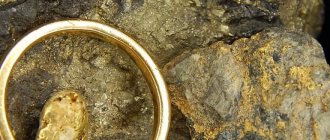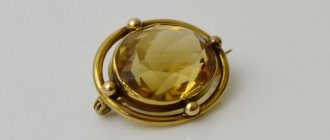For centuries, gold was considered the most valuable noble metal, which played a key role in a wide variety of areas of human activity.
But if in ancient times there were no specific methods for extracting this material, in addition to developing mines, then today things are much better and it is possible to extract a certain amount of gold from stone.
general information
Modern science knows which stones contain gold, so there are practically no difficulties with its extraction. Particles of precious metal are present in the veins of various rocks, and advanced technologies make it possible to determine their authenticity, as well as distinguish them from other, worthless materials.
In nature, gold can be found in the following forms:
- Nuggets.
- Fine-grained placers.
- Powder dust.
It is found in veins of stones and rocks, which are located in mountain rivers, among rocks and mountains, in sea sand, and also together with other minerals. Knowing which stones contain gold, you can remove it without much difficulty. The extraction of precious metal occurs through refining.
Before you start extracting it, you need to make sure that it is really a precious metal and not iron pyrite or zinc. Many minerals resemble yellow treasure with their characteristic shine, but they crumble very quickly under mechanical stress. As for gold-containing stones, they only scratch.
Fake gold sands and placers may look identical to pure gold, but they differ from it in a number of properties. The satellites of gold are intrusive rocks that were formed due to the solidification of magma.
Among them:
- Quartz diorites.
- Granite.
- Quartz.
The closest neighbors of the yellow metal are galerites, pyrites, stibnites, arsenopyrites and other similar minerals. Removing a valuable find from granite is incredibly difficult; this requires complex installations and professional equipment.
When figuring out how to extract gold from stone at home, you need to understand that mining methods may differ depending on its composition and other features. To accomplish this task, a lot of chemical methods are used. When processing lead sulfite, a mechanical action is carried out, which allows you to break the stone into small cubes, and then get the desired find from there.
Quartz diorites and quartz also have an impressive content of precious metal. They can be found in rocks, rivers and rocks, as well as in sea sand and on the pebbles of the bottom of various natural bodies of water. Tiny metal particles look like gold deposits.
Jewelry horoscope
Despite the fact that many consider this to be common prejudice, minerals actually improve the health of their owners.
For this reason, stones in accordance with the zodiac sign must be chosen wisely:
- Aries - green diamond, garnet, lilac amethyst, zircon, red jasper.
- Gemini - moonstones, pearls; for men - gold rings with stones (alexandrites, beryl).
- Cancer - pearls, amethysts, moonstones, onyx, black agates.
- Leo - garnet, topaz, ruby, amber.
- Virgo - pearls, agates, emeralds, jades, sapphires.
- Libra - malachite, amethyst, opal, tourmaline.
- Scorpio - turquoise, corals, sardonyx, beryl, topaz, emeralds, bloodstone, black opal.
- Sagittarius - tiger's eye, amethysts, agates, turquoise, opals, golden peridot stones.
- Capricorn - topaz, rock crystal, carnelian, agate, onyx, flint, alexandrite.
- Aquarius - pearls, jades, amber, sapphires.
- Pisces - amethysts, aquamarines.
Both ancient and modern astrologers claim that the impact of stones on a person’s fate and health is predetermined by the location of the zodiac constellations and planets. And those gold jewelry with stones that are combined with the symbol under which the person was born are considered more suitable.
Search for gold
How to find rock that may contain valuable yellow metal is not difficult to understand. The gold mining industry is developing in several countries where natural deposits of this rock are located. Among them:
- China, which ranks first in terms of gold mining volumes.
- Australia.
- Russian Federation.
- USA.
- Canada.
- SOUTH AFRICA.
- And some other countries where gold mining is carried out on a smaller scale.
Russia is in third place on the list, behind China and Australia in terms of precious metal production. Several deposits were found on the territory of the state, 95% of which are located in the regions of the Far East, in the Amur, Krasnoyarsk and Irkutsk regions, as well as in Chukotka. Gold is also mined in Buryatia, Transbaikalia, Khabarovsk and Krasnoyarsk territories. The latter region is considered the leader in terms of volumes of precious metal extraction from the ground.
Jewelry with natural stones
White gold brooch with diamonds
829,542.00 ₽ View in store
Brooch in white gold with diamonds and chrome diopsides
109,235.00 ₽ View in store
White gold brooch with diamond and garnet
48,360.00 ₽ View in store
White gold necklace with diamonds and chrome diopsides
848,449.00 ₽ View in store
White pearl bracelet 7 mm 15 cm (585 gold)
14,690.00 ₽ View in store
Rauchtopaz ring (585 gold) cut size 18
17,390.00 ₽ View in store
Ring topaz blue (gold 585 pr.) size 17
20,890.00 ₽ View in store
Blue cut topaz pendant (585 gold)
8,490.00 ₽ View in store
Earrings rauchtopaz (gold 585 etc.) cut
32,090.00 ₽ View in store
Earrings topaz blue (gold 585 pr.)
28,590.00 ₽ View in store
Ring emerald cut (585 gold) size 17
30,590.00 ₽ View in store
Emerald oval cut pendant (585 gold)
34,890.00 ₽ View in store
Sapphire cut earrings (585 gold)
33,590.00 ₽ View in store
Diamond cut pendant (925 silver, 585 gold)
42,590.00 ₽ View in store
Identification of deposits in nature
In the era of free access to any information, it is not difficult to understand how to identify gold in a stone. But before that, you need to consider the list of the most promising places in which such a metal is likely to be present. Theoretically, particles of gold can be present in a wide variety of stones, but their quantity is so minute that it is not of particular value. If you want to engage in more serious mining, you need to count on luck and follow the principles of identifying deposits.
A small amount of the precious metal is found in sea water . Experts say that if all gold reserves are removed from the waters of the World Ocean, their quantity will reach 10 billion tons. The figure looks shocking, but modern science does not know any methods for extracting metal from the hydrosphere.
In its pure form, gold is extremely rare, especially when it comes to stones containing this noble metal. In most cases, yellow treasure is found along with various impurities that need careful processing. It is possible to find pure material in large quantities in quartz formations. Such formations are constantly exposed to wind and rain, which causes their destruction. As a result of this process, a single piece of gold nugget is formed.
Natural reserves of gold are also contained in the following deposits:
- Eluvial.
- Residual.
- Bottom.
- Terraced.
Residual deposits are observed near the vein itself, which was under physical or chemical influence. The eluvial type is found directly at the foot of the mountains.
Terrace deposits can be identified at the bottom of reservoirs, usually rivers, which erode the earth, forming an additional bottom. The old bottom layer turns out to be above ground level, which makes it look like a kind of terrace. And the older this terrace, the higher the likelihood of successfully identifying a large number of valuable reserves. Sediments end up at the bottom through precipitation, and under the influence of rain and currents they are washed ashore.
Types of cuts
Its brilliance and the play of light on the surface largely depend on the cut of a gemstone. Cutting refers to the technique of processing a mineral, upon completion of which a certain shape of a stone is formed with a certain number of faces, their location, proportions relative to each other and characteristic outlines. Let's look at the most commonly used types of cuts:
Round cut
Number of faces: 17, 33, 57
The round cut is something of a classic. The history of this cut goes back more than a hundred years. It is perfect for diamonds, as it collects and enhances the shine of the stone. In addition, the round cut protects the gemstone from chips and other damage. The lighter the stone (the smaller the carat), the fewer facets the jeweler will carve. Fly in the ointment - with this cut, up to 50% of the original weight of the gem is lost.
Oval cut
Number of faces: 57
This option for cutting stones has been known since the 60s of the 20th century. The “oval” cut has a more elongated shape than the round cut; and allows the stone to play with iridescence in the light. Gems cut into oval shapes are often used in rings to visually lengthen the fingers.
Marquise cut
Number of faces: 55
The Marquise cut is similar to a boat and is an oblong oval with pointed corners at the edges. As with the oval cut, the marquise cut on the ring elongates the fingers. However, be aware that the sharp wedges at the ends of the stone will become vulnerable and brittle.
Drop cut (Pear)
Number of faces: 55-56
The “Drop” combines the features of the “Marquise” and “Oval” cuts - on one side the gem will have a rounded end; and on the other hand, it’s spicy. The sharp end acts as a vulnerable point of the gemstone, prone to cracks. Therefore, experienced jewelers try to protect it with a frame. A teardrop-shaped cut of a gem in a necklace or necklace will advantageously lengthen the neck.
Princess cut
Number of edges: 49, 65,68
The “Princess” has a square or more often rectangular shape. Like the round cut, the Princess cut maximizes the brilliance and brilliance of the gem. In addition, when choosing this cut, the nugget will lose less of its original weight. This cut is often used for engagement ring diamonds. Like any other sharp corners, the tops of the “Princess” must be reliably protected by the frame.
Cabochon
Cabochoning is a method of processing stone to give it a rounded, convex shape (sometimes flat on one side). Most often, this cutting method is used when processing impenetrable or low-permeability stones; as well as stones that have any optical effects (for example, asterism or opalescence).
Extraction methods
One of the oldest, but also the most dangerous methods for extracting gold from stones is amalgamation. Today, the technique is officially prohibited in the Russian Federation, but continues to be in demand in other countries, as well as among “black” miners. To extract the precious metal, mercury is used, which is placed in a plastic or glass tray with existing sand and the smallest fractions of the yellow treasure.
It is known that mercury is not able to dissolve gold, but can draw it into its balls. To speed up the process, the gold miner regularly turns the tray, allowing the substance to roll completely over its entire surface.
Mercury beads combined with gold are called amalgam . After separating such a mixture from the sand, it is additionally treated with hydrochloric acid, which promotes the dissolution of mercury, but has no effect on gold. The method of evaporating toxic mercury under the influence of fire is also practiced. Similar manipulations were carried out directly in the frying pan. Once in the acid, the gold settles to the bottom in the form of flakes, after which it is subjected to deep washing. If you want to preserve mercury for further operations, a piece of foil is lowered into the acid. Thus, the mercury precipitates.
The next method of gold extraction, known since ancient times, is panning. Unlike the previous method, washing is considered completely safe for the body and does not harm the environment. The method is based on the special properties of the precious metal, namely its high density. Flushing is relevant for both industrial and private mining. It also continues to be practiced in placer deposits.
The technological process itself consists of washing the sand with water, as a result of which the light fractions are quickly removed, while the heavy fractions remain at the bottom. The disadvantage of this technique is that too small particles are washed out by water, which significantly reduces production productivity. When wondering whether it is possible to engage in private gold mining in this way, you need to pay attention to the relevant law. It involves the purchase of a prospector's license valid for up to five years.
Home techniques
Industrial gold mining differs significantly from private gold mining, and the methods used have many advantages. If you know how to identify gold in a stone, you can successfully remove it from there using the most primitive methods.
And you don’t have to go to distant Siberia in search of abandoned mines. You can implement the idea of withdrawing precious metals at home. Back in the days of the Soviet Union, skilled craftsmen extracted it from old watches and other yellow metal products. In the recent past, gold plating was present on many radio components and household appliances, which was justified by its practicality and resistance to corrosion. Without a doubt, the percentage of gold content in such objects is negligible, but in the rock it is not that high.
If you want to get the precious yellow material at home, just take an old wristwatch and then fill it with nitric acid in glass or plastic containers. The substance will quickly dissolve any materials except gold. The resulting solution must be carefully passed through several layers of gauze, and the seized gold must be infused in vodka for 24 hours. This will result in a brownish tint.
In the future, it is necessary to rinse the composition with plain water, filter again and put on low heat to melt. To improve the efficiency of the latter process, soda is added to the gold. We must not forget about the ability of the yellow metal to evaporate, but through melting it is cleared of excess impurities and becomes like a tiny ingot.
Gold can also be extracted from radio components , in which it was used back in the Soviet Union due to its inertness and minimal electrical conductivity. To implement such an idea, you need to use “regia vodka”, which consists of nitric and hydrochloric acid. Such a substance can dissolve gold at room temperature. By the way, there are historical facts about the dissolution of gold medals in order to hide them from the fascist military. Under the influence of aqua regia, gold precipitates, after which it is thoroughly filtered and washed.
Historical facts
If you familiarize yourself with historical facts, you will know that during the times of Ancient Rus', the state had practically no gold deposits, despite its vast area. Prince Ivan III devoted a significant part of his life to the issue of searching for precious metals, because he was practically obsessed with the idea of \u200b\u200bsearching for treasures. To realize his dream, he even invited Italian specialists and allocated impressive sums. But the efforts were not justified; he managed to find only a small piece of gold, which was only enough to make a tiny cross.
After him, Ivan the Terrible began to actively search for yellow sand. To find the valuable metal, he even went to war against the Siberian settlements, but was also doomed to failure. A similar story happened with the rest of the rulers of Ancient Rus', until a turning point in the history of the state occurred. This was the rise to power of Peter I. The legendary ruler began to actively introduce clothing items and jewelry containing precious metals and valuable stones.
The first gold nugget was mined by a Ural peasant in 1945. This happened spontaneously while digging a hole. The happy owner of the precious stone immediately showed the find to a friend, who turned out to be a silversmith and confirmed the authenticity of the nugget.
The place where the find was discovered immediately attracted the attention of specialists, which led to the start of numerous search operations. However, they were unable to find anything, so work was suspended. Soon the authorities decided to resume the search and equip the mine. This decision paid off. At the bottom of the dug mine there was an impressive amount of gold reserves, which became the basis for large-scale gold mining.
Since ancient times, people have been interested in the idea of mining gold at home. Today, this trend is no less popular, only the methods of its implementation have changed significantly. Of course, you won’t be able to get rich through private gold mining, but finding a new hobby, as well as a little extra income, is quite possible.











